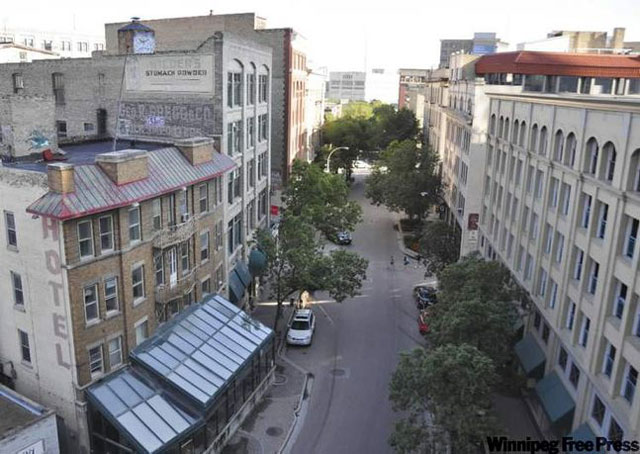
Every year at the height of summer, the Fringe Festival invades Winnipeg and the cobblestone sidewalks of the Exchange District come alive as artists' kiosks, shops and restaurants overflow with people late into the evening.
It's almost as if, for a short time, our tranquil warehouse district masquerades as a little piece of New York's Greenwich Village. When the Fringe moves on and the streets again fall quiet, we are left to wonder what might be done to capture a small piece of that vibrancy and maintain it throughout the year.
The latest edition of the Fringe may have inadvertently uncovered an idea worth investigating in an effort to accomplish this goal. Construction at the Union Tower forced the relocation of the kiosks and children's stage to Albert Street, which was closed to automobiles. This lured people away from Old Market Square and into the neighbourhood, increasing foot traffic and economic activity to the adjacent businesses. In light of this success, might a similar move be considered a permanent strategy for the area?
Creating pedestrian malls by closing streets to vehicles was an idea explored across North America 40 years ago as cities battled against the draw of suburban shopping centres. More than 200 cities closed streets in their failing downtowns, rolling out benches and planters in hopes it would bring shoppers back to the core. In the end, almost 80 per cent of these developments failed and were eventually reopened to cars.
Four decades removed from the 1970s, urban planners are again pulling on their bell bottom jeans and disco boots as they reconsider the strategy of creating pedestrian streets to enhance the character and economy of a downtown. There's a greater understanding today of what conditions are necessary to make a pedestrian arcade successful.
In Montreal, they have confidently resurrected this idea by creating four new car-free zones in the past year.
Pedestrian malls in the past were wrongly seen as a means of reversing a downward economic trend in urban areas. Closing main commercial streets to the high-volume, drive-by traffic that retailers relied on often accelerated the economic decline. While not a solution for struggling neighbourhoods, the unique attraction of a pedestrian arcade can successfully enhance an already thriving retail destination such as the Exchange District.
A short but active pedestrian mall along Albert Street connecting Old Market Square to the well-used Canwest Plaza on Portage Avenue may begin to draw some of the thousands of office workers at Portage and Main into the Exchange District while returning some of its small-scale commercial success to the larger street.
A strong focal point at each end, linked with a tree-lined pedestrian corridor, might act as a linear park and urban gathering space unique in the downtown.
Adjacent to Old Market Square and the two blocks of Albert Street there are currently 14 restaurants, 20 retailers, a spa, three pubs, three galleries and two hotels. This burgeoning, trendy neighbourhood already relies on pedestrian activity for its success, and might benefit from the added exposure and marketing that a distinctive, vehicle-free arcade would bring.
Only a few years ago, the residential and commercial activity in the area would have not been able to support such an idea. But with more than 1,000 new residential units planned or completed in the Exchange, this vital component is starting to be realized. Today, a pedestrian mall might enhance this growing neighbourhood.
Successful pedestrian streets can be found in Halifax, Quebec City, Montreal and Calgary. All of these are defined by densely organized, human-scale, heritage buildings that provide variation and visual interest over a short walking distance, and allow leaf-filtered sunlight down to the sidewalk.
The physical and economic character of the Exchange District is such that it might be able to successfully navigate the obstacles that have caused this idea to fail in the past.
The long-term feasibility of a pedestrian mall would be improved if it were implemented as part of a larger policy promoting pedestrian activity throughout the downtown. Complementary strategies such as reopening Portage and Main, reducing surface parking such as the ill-conceived lot dissecting Old Market Square, and continuing efforts to encourage residential development would work together to find mutual, lasting success.
It would be ironic if Winnipeg, a city slow to embrace new ideas, chose to become a leader in reinventing a strategy that was considered the "latest thing" 40 years ago. Along with the return of muscle cars, vinyl records and aviator sunglasses, the pedestrian arcade might also find its way back from the 1970s and be successfully transformed into an idea for today.
Brent Bellamy is senior design architect for Number Ten Architectural Group. Email him at Bbellamy@numberten.com.
Republished from the Winnipeg Free Press print edition August 16, 2010 B3

